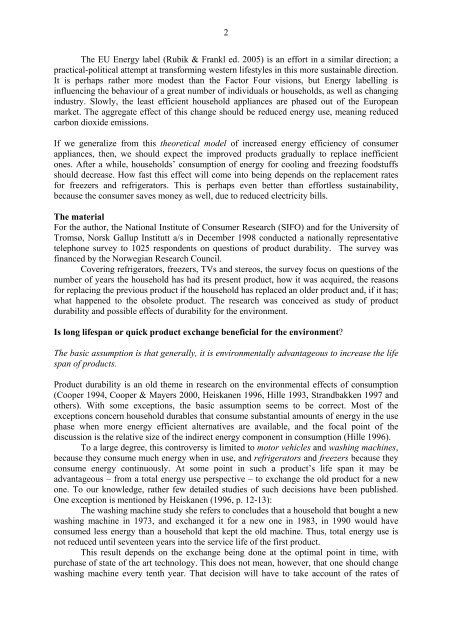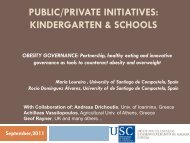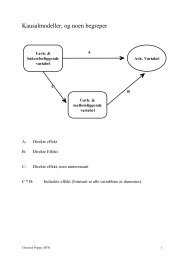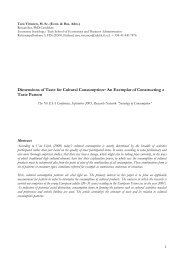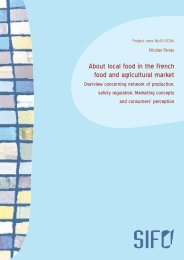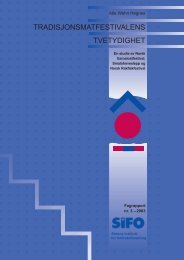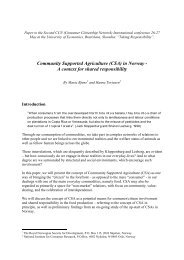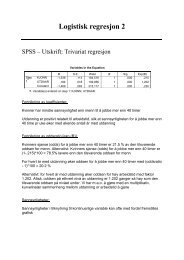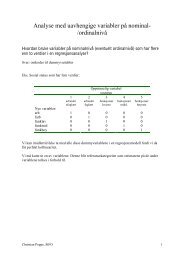Social Constraints to Eco Efficiency: Refrigerators and freezers - SIFO
Social Constraints to Eco Efficiency: Refrigerators and freezers - SIFO
Social Constraints to Eco Efficiency: Refrigerators and freezers - SIFO
Create successful ePaper yourself
Turn your PDF publications into a flip-book with our unique Google optimized e-Paper software.
2The EU Energy label (Rubik & Frankl ed. 2005) is an effort in a similar direction; apractical-political attempt at transforming western lifestyles in this more sustainable direction.It is perhaps rather more modest than the Fac<strong>to</strong>r Four visions, but Energy labelling isinfluencing the behaviour of a great number of individuals or households, as well as changingindustry. Slowly, the least efficient household appliances are phased out of the Europeanmarket. The aggregate effect of this change should be reduced energy use, meaning reducedcarbon dioxide emissions.If we generalize from this theoretical model of increased energy efficiency of consumerappliances, then, we should expect the improved products gradually <strong>to</strong> replace inefficien<strong>to</strong>nes. After a while, households’ consumption of energy for cooling <strong>and</strong> freezing foodstuffsshould decrease. How fast this effect will come in<strong>to</strong> being depends on the replacement ratesfor <strong>freezers</strong> <strong>and</strong> refrigera<strong>to</strong>rs. This is perhaps even better than effortless sustainability,because the consumer saves money as well, due <strong>to</strong> reduced electricity bills.The materialFor the author, the National Institute of Consumer Research (<strong>SIFO</strong>) <strong>and</strong> for the University ofTromsø, Norsk Gallup Institutt a/s in December 1998 conducted a nationally representativetelephone survey <strong>to</strong> 1025 respondents on questions of product durability. The survey wasfinanced by the Norwegian Research Council.Covering refrigera<strong>to</strong>rs, <strong>freezers</strong>, TVs <strong>and</strong> stereos, the survey focus on questions of thenumber of years the household has had its present product, how it was acquired, the reasonsfor replacing the previous product if the household has replaced an older product <strong>and</strong>, if it has;what happened <strong>to</strong> the obsolete product. The research was conceived as study of productdurability <strong>and</strong> possible effects of durability for the environment.Is long lifespan or quick product exchange beneficial for the environment?The basic assumption is that generally, it is environmentally advantageous <strong>to</strong> increase the lifespan of products.Product durability is an old theme in research on the environmental effects of consumption(Cooper 1994, Cooper & Mayers 2000, Heiskanen 1996, Hille 1993, Str<strong>and</strong>bakken 1997 <strong>and</strong>others). With some exceptions, the basic assumption seems <strong>to</strong> be correct. Most of theexceptions concern household durables that consume substantial amounts of energy in the usephase when more energy efficient alternatives are available, <strong>and</strong> the focal point of thediscussion is the relative size of the indirect energy component in consumption (Hille 1996).To a large degree, this controversy is limited <strong>to</strong> mo<strong>to</strong>r vehicles <strong>and</strong> washing machines,because they consume much energy when in use, <strong>and</strong> refrigera<strong>to</strong>rs <strong>and</strong> <strong>freezers</strong> because theyconsume energy continuously. At some point in such a product’s life span it may beadvantageous – from a <strong>to</strong>tal energy use perspective – <strong>to</strong> exchange the old product for a newone. To our knowledge, rather few detailed studies of such decisions have been published.One exception is mentioned by Heiskanen (1996, p. 12-13):The washing machine study she refers <strong>to</strong> concludes that a household that bought a newwashing machine in 1973, <strong>and</strong> exchanged it for a new one in 1983, in 1990 would haveconsumed less energy than a household that kept the old machine. Thus, <strong>to</strong>tal energy use isnot reduced until seventeen years in<strong>to</strong> the service life of the first product.This result depends on the exchange being done at the optimal point in time, withpurchase of state of the art technology. This does not mean, however, that one should changewashing machine every tenth year. That decision will have <strong>to</strong> take account of the rates of


